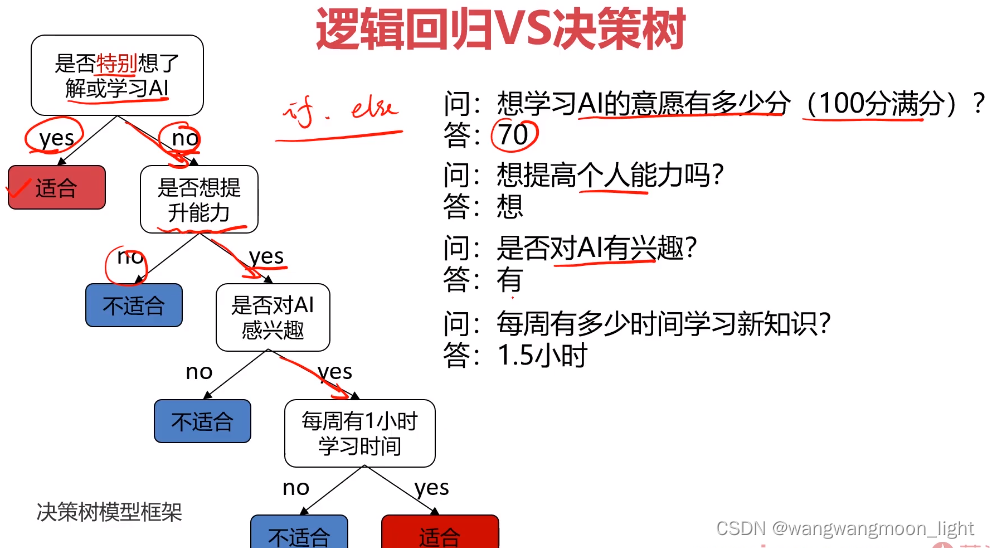机器学习算法详解:从线性回归到深度学习,掌握机器学习核心技术
发布时间: 2024-08-25 09:08:56 阅读量: 24 订阅数: 35 


# 1. 机器学习基础
机器学习是人工智能的一个子领域,它赋予计算机从数据中学习的能力,而无需明确编程。机器学习算法可以根据历史数据中的模式和关系,对新数据做出预测或决策。
机器学习算法分为监督学习和非监督学习两大类。监督学习算法使用带有已知标签或输出的数据进行训练,而非监督学习算法则使用未标记的数据。监督学习算法的典型示例包括线性回归、逻辑回归和决策树,而非监督学习算法的示例包括聚类算法和降维算法。
# 2. 监督学习算法**
监督学习算法是机器学习中最基础和重要的算法类型之一,它主要用于解决分类和回归问题。在监督学习中,算法会从标记的数据中学习,并建立一个模型来预测新数据的输出。
**2.1 线性回归**
线性回归是一种用于预测连续变量的监督学习算法。它假设输入变量和输出变量之间存在线性关系,并通过最小化平方误差来找到最佳拟合线。
**2.1.1 线性回归模型**
线性回归模型可以表示为:
```
y = β0 + β1x1 + β2x2 + ... + βnxn + ε
```
其中:
* y 是输出变量
* x1, x2, ..., xn 是输入变量
* β0, β1, ..., βn 是模型参数
* ε 是误差项
**2.1.2 线性回归的求解方法**
线性回归模型的参数可以通过最小化平方误差来求解,即:
```
min Σ(y - ŷ)^2
```
其中:
* y 是真实输出
* ŷ 是预测输出
求解该优化问题的方法有很多,其中最常用的是最小二乘法。
**代码块:**
```python
import numpy as np
import pandas as pd
from sklearn.linear_model import LinearRegression
# 准备数据
data = pd.read_csv('data.csv')
X = data[['x1', 'x2']]
y = data['y']
# 训练模型
model = LinearRegression()
model.fit(X, y)
# 预测新数据
new_data = pd.DataFrame({'x1': [10], 'x2': [20]})
y_pred = model.predict(new_data)
# 输出预测结果
print(y_pred)
```
**逻辑分析:**
* 该代码块使用最小二乘法训练了一个线性回归模型,并使用新数据进行了预测。
* `LinearRegression()`函数用于创建线性回归模型。
* `fit()`方法用于训练模型,传入输入数据和输出数据。
* `predict()`方法用于使用训练好的模型对新数据进行预测。
**参数说明:**
* `data.csv`:包含训练数据的CSV文件。
* `x1`、`x2`:输入变量的列名。
* `y`:输出变量的列名。
* `model`:训练好的线性回归模型。
* `new_data`:包含新数据的DataFrame。
* `y_pred`:预测输出。
# 3. 非监督学习算法
非监督学习算法是一种机器学习算法,它从未标记的数据中学习模式和结构。与监督学习算法不同,非监督学习算法不需要预先定义的目标变量或输出。相反,它们根据数据的相似性或差异性将数据点分组或转换。
### 3.1 聚类算法
聚类算法是将数据点分组到称为簇的相似组中的非监督学习算法。每个簇中的数据点彼此相似,但与其他簇中的数据点不同。聚类算法广泛用于数据探索、客户细分和异常检测。
**3.1.1 K-Means聚类**
K-Means聚类是一种流行的聚类算法,它将数据点分配到K个簇中,其中K是一个预先定义的数字。该算法通过以下步骤工作:
1. **初始化:**随机选择K个数据点作为初始簇中心。
2. **分配:**将每个数据点分配到距离其最近的簇中心。
3. **更新:**计算每个簇的平均值,并将簇中心更新为这些平均值。
4. **重复:**重复步骤2和3,直到簇中心不再改变。
**代码块:**
```python
import numpy as np
from sklearn.cluster import KMeans
# 数据点
data = np.array([[1, 2], [3, 4], [5, 6], [7, 8], [9, 10]])
# 创建K-Means模型
kmeans = KMeans(n_clusters=2)
# 拟合模型
kmeans.fit(data)
# 获取簇标签
labels = kmeans.labels_
# 打印簇标签
print(labels)
```
**逻辑分析:**
* `n_clusters`参数指定要创建的簇数。
* `fit()`方法将模型拟合到数据。
* `labels_`属性包含每个数据点的簇标签。
**3.1.2 层次聚类**
层次聚类是一种聚类算法,它创建一棵称为树状图的层次结构,其中每个节点代表一个簇。该算法通过以下步骤工作:
1. **初始化:**将每个数据点视为一个单独的簇。
2. **合并:**找到距离最近的两个簇,并将其合并为一个新的簇。
3. **重复:**重复步骤2,直到所有数据点都被合并到一个簇中。
**代码块:**
```python
import numpy as np
from sklearn.cluster import AgglomerativeClustering
# 数据点
data = np.array([[1, 2], [3, 4], [5, 6], [7, 8], [9, 10]])
# 创建层次聚类模型
clustering = AgglomerativeClustering(n_clusters=2)
# 拟合模型
clustering.fit(data)
# 获取簇标签
labels = clustering.labels_
# 打印簇标签
print(labels)
```
**逻辑分析:**
* `n_clusters`参数指定要创建的簇数。
* `fit()`方法将模型拟合到数据。
* `labels_`属性包含每个数据点的簇标签。
### 3.2 降维算法
降维算法是将高维数据转换为低维表示的非监督学习算法。这可以简化数据可视化、提高算法效率并减少过拟合。
**3.2.1 主成分分析(PCA)**
PCA是一种降维算法,它通过找到数据中方差最大的方向来创建低维表示。该算法通过以下步骤工作:
1. **计算协方差矩阵:**计算数据点的协方差矩阵,该矩阵表示数据点之间的相关性。
2. **计算特征值和特征向量:**计算协方差矩阵的特征值和特征向量。
3. **选择主成分:**选择具有最大特征值的特征向量作为主成分。
**代码块:**
```python
import numpy as np
from sklearn.decomposition import PCA
# 数据点
data = np.array([[1, 2], [3, 4], [5, 6], [7, 8], [9, 10]])
# 创建PCA模型
pca = PCA(n_c
```
0
0





